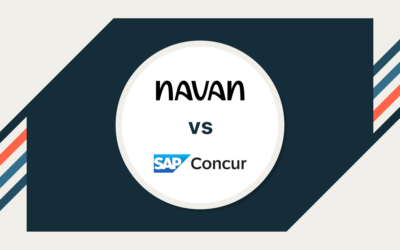Filing 1099s. The annual task that is chock-full of challenges arrives right when most organizations are scrambling to close out their year-end. You’ve got to recall the rules, get access to accurate data, and file reports with vendors and the tax authorities — all with penalties from the IRS for mistakes and omissions hanging over your heads.
But you can create year-round processes that eliminate the year-end chaos. And by leveraging the right tools, you can tackle 1099 reporting with confidence and relative ease.
In a recent live session hosted by Airbase and Avalara, Rebecca Colman, Director of TACS at SOAProjects, shared her take on understanding 1099 compliance. With experience spanning leading organizations like Square Trade, Oracle, and Allstate, Rebecca provided practical strategies for staying compliant while reducing stress.
From understanding your obligations to using technology to streamline workflows, the session gave a helpful roadmap to making the process easier.
Step 1: Build W-9 collection in your processes year-round.
Rebecca stressed that W-9 is the basis for all 1099 reporting and the form should be received from every vendor you make a payment to. The W-9 tells you what type of entity the vendor is and, in most cases, that type will determine whether or not you will need to file a 1099 for the payments you make to them. For example, most payments to corporate entities do not require a 1099.
As the segment on Airbase showed, collecting this vital document can be made easier if it is automatically wrapped into your vendor onboarding process. It is even better if your vendor management system also provides reporting for any missing W-9s.
Once an entity is designated as one that needs to receive a 1099 form, you’ll need to report payments to them both to the individual or entity and to the tax authorities (Federal and State) by the filing deadline, which is January 31 this year.
Avoid penalties.
Rebecca started her session with a warning:
“I want to point out, and I’m sure nobody wants to go there, that there are penalties for non-compliance. Right now, the numbers have changed.”
Penalties have changed due to inflation, she says, so failing to issue Form 1099-NEC or Form 1099-MISC by the deadline can result in penalties ranging from $60 to $660 per form for tax year 2024, depending on how late the form is filed.
“I don’t think anybody wants to be dealing with these amounts and they can get exponentially into the millions,” she said.
Step 2: Understand your Form 1099 obligations.
Before you start, you need a clear understanding of IRS regulations, the different types of 1099 forms, and who is considered an independent contractor.
Who gets a Form 1099?
If you paid independent contractors or self-employed individuals more than $600 in 2024, you must complete an IRS Form 1099 and send Copy A of the form to the IRS. Copy B must be sent to the independent contractor.
There is one exception to the $600 cut-off, which is that any royalties paid over $10 must be reported as taxable income.
Pro tip: Ensure all independent contractors submit a W-9 as part of your vendor onboarding process. Make sure all contact info is up to date. (A vendor portal where vendors can update their own information will save you headaches.)

Form 1099-NEC.
In 2020, the IRS introduced Form 1099-NEC (which stands for non-employee compensation). The majority of 1099s that businesses send out will be Form 1099-NEC.
Use Form 1099-NEC for:
- $600 or more of services paid to non-employees.
- Payments of more than $5,000 of consumer products for resale.

Form 1099-MISC.
The older form, 1099-MISC, is now used for miscellaneous expenses, such as:
- Medical or healthcare services.
- Rent.
- Fishing boat proceeds.
- Gross proceeds paid to an attorney.
- Section 409A deferrals.
- Non-qualified deferred compensation.
- Royalties or broker payments in lieu of dividends of $10 or more.

Reporting reminder:
Do not report payments to exempt recipients.
- Corporations:
- Unless the payee is a law firm or attorney.
- Unless the payment is for medical or healthcare services.
- Tax-exempt entities.
- Government agencies.
Know the filing thresholds.
To report payments made in 2024, you must file electronically if you’re filing 10 or more aggregate returns.
Previously, the threshold was 250, and it was applied separately to each tax form type, so this is a significant change.
The filing threshold for 1099-K has also changed. The threshold is now $5,000.
Who doesn’t receive a Form 1099?
- 1099s do not need to be issued to C-Corps (check the W-9 to see if they are a C-Corp), with the exception of medical and health payments, gross proceeds paid to attorneys, or substitute payments in lieu of dividends or tax-exempt, all of which require a 1099-MISC.
- Tax-exempt entities, government agencies, and foreign payees should also not receive a 1099 form.
- 1099s are also not required for things such as business travel expenses, employee expense reimbursement, office supplies, freight, storage, or similar items, or rent if the payments are made to real estate agents or property managers.
- Income paid to foreign persons, including non-resident aliens and foreign corporations, is reported on Form 1042 instead of Form 1099. Effective for 2023 reporting, Form 1042 must be filed electronically. This is another significant change, as Form 1042 was typically only filed by paper.
Internal Revenue Service deadlines to note.
Deadlines are a critical part of the 1099 requirements, and you will be penalized if you miss one. Here are some key dates to report payments made in 2024:
January 31, 2025: 1099-NEC due to IRS and vendors. 1099-MISC due to vendors.
March 31, 2025: Deadline for the 1099-MISC to be filed electronically with the IRS.
Rebecca noted that it is possible to apply for an electronic filing waiver for things like natural disasters, “but there are a lot of hoops to jump through. You have to do some work. It’s not automatically granted through the IRS.”
Combined Federal/State Filing program.
The Combined Federal/State Filing program (CF/SF) facilitates the electronic submission of tax forms, such as Form 1099, to both the Internal Revenue Service (IRS) and participating state tax agencies.
This streamlined program aims to simplify and expedite the reporting process for businesses, ensuring compliance with federal and state tax regulations.
Rebecca was careful to point out that the regulations around CF/SF are complex and have undergone recent changes, so do your due diligence on how they affect your company.
What if I am going to be late filing my 1099?
It happens. Businesses might realize they’re missing crucial data when preparing their information returns. If you find yourself in such a situation and it looks like you won’t make the deadline, it’s important to address the issue promptly.
If the deadline appears unrealistic, you can request a 30-day extension using Form 8809.
“If you know in advance you’re going to need more time, I would highly recommend that you get a 30-day extension,” Rebecca said.
Step 3: Develop a foundation for your game plan.
Gordon Walsh from Avalara says the IRS estimates that it takes an average of 18 minutes to complete a single 1099 form. For an organization with multiple vendors, that can add up to hours of valuable time.
Getting a head start with the right processes and validated information will cut that time. 1099 forms are easier when the end goal is embedded in the process. That way, you are on top of 1099 filings throughout the tax year, with all the necessary information and tax documents to hand.
An AP automation platform that addresses the entire payment process, from initial request to GL sync, will take 1099 requirements into account every time a bill is paid.
Here’s how Airbase helps.
- The minute a vendor is added to the system, simply indicate if the vendor fits the criteria for receiving a 1099.
- If it does, Airbase collects their tax information by having the vendor fill out and submit a W-9 form. The W-9 has all of the relevant information you will need for the 1099 forms: name, address, contact information, email address (preferably for the accounting department), and EIN/SSN.
- Airbase will flag vendors who haven’t submitted a required W-9.
- Airbase leverages the vendor’s legal business name and Taxpayer Identification Number (TIN) during onboarding and within the vendor profile to validate tax ID information. This process involves matching key vendor account fields with corresponding government records to ensure accuracy and global compliance, and reduce risk. For example, if a vendor’s tax ID is issued by the U.S. government, Airbase cross-checks the tax ID details with IRS records.
- Legal Name: The vendor’s business name as officially registered with the relevant government authority, such as the IRS.
- Tax ID: The vendor’s Taxpayer Identification Number (TIN).
- In Airbase, a vendor’s contracts, invoices, W-9s, and other documents are attached to the same record, so you have everything you need to manage payments for that vendor in one place.
- Airbase’s spend analytics functionality will produce a real-time report showing those vendors, together with other vital tax information you’ll need for 1099 reporting.
The Vendors Report includes the following fields for each vendor, all in a consolidated CSV file for easy data transfer.
- Name.
- Primary email.
- Type.
- 1099 Vendor: This indicates if they’re marked as 1099 on the W-9.
- Tax ID.
- W-9 URL: The URL to the W-9 uploaded to Airbase, if it’s available.
- Address, including City, State, and ZIP.
- Amount Paid (Virtual Card): Shows the amount paid to the vendor by Airbase virtual cards. Also includes the bills paid by virtual cards.
- Amount Paid (Bill Payments): Shows the amount paid to the vendor by check or ACH.
- Vendor Details: URL to the Vendor Details page in Airbase.
- Last Payment Date: The date the vendor was last paid in Airbase.
Here’s how Avalara helps:
- Form completion: Populates 1099 forms with payee data.
- Automated e-filing and delivery: Files electronically with the IRS and applicable states, and ensures recipients receive their 1099 copies on time.
- Reduces risk of penalties: Flags potential errors before filing with the IRS.
- Maintains audit-readiness: Avalara provides a centralized, secure platform to manage IRS forms and ensures quick access to files during an IRS audit.

AP Automation Tour
Explore 3-way matching in our AP Automation Product tour.
Step 4: Strategically shift the reporting burden when possible.
When a vendor is paid by credit card, PayPal, or other types of payment processors, the 1099 obligation moves to the payment processing company. This is one reason why astute finance teams are moving bill payments to their card programs.
With a payment-agnostic AP automation platform, such as Airbase, you can make bill payments through your corporate card program and shift the burden of 1099 reporting to the card company.
It’s an easy way to avoid 1099 forms (as fun as they are) without any extra work on your part. As an added bonus, you can earn cash back on card spending. Think of it as monetizing accounts payable.
Note: PayPal terms and conditions should be examined carefully, since some PayPal products indicate they are not responsible for the 1099 forms.

Some Q&A from the session.
Please note: Airbase does not provide tax, legal, or accounting advice. The following information has been prepared for informational purposes only and is not intended to provide, and should not be relied on for, tax, legal, or accounting advice. You should consult your own tax, legal, or accounting advisors before engaging in any transaction.
Do I file a 1099 form for travel reimbursements?
Only non-employees receive a 1099 for travel expenses, and only if they don’t submit a detailed expense report indicating it’s a reimbursement.
Are payments to attorneys reportable?
Again, this is dependent on the nature of the payment.
Gross fees payable to an attorney are reported in Box 14 of 1099-MISC. This includes litigation-related payments.
For example, if your company settles a lawsuit and you pay the attorney part of the settlement, that belongs on Form 1099-MISC.
On the other hand, fees paid for legal services, such as insurance contract reviews, are reported in Box 1 of 1099-NEC.
What kind of health costs need to be reported?
These should be discussed with a tax advisor but in general:
Box 6 instructions. Enter payments of $600 or more made in the course of your trade or business to each physician or other supplier or provider of medical or health care services. Include payments made by medical and health care insurers under health, accident, and sickness insurance programs. If payment is made to a corporation, list the corporation as the recipient rather than the individual providing the services.
Can I file multiple Form 1099s for the same vendor?
You can file multiple 1099 forms for the same vendor for the same business entity (although they may not be thrilled to receive a 1099 form multiple times from you).
The IRS requires that you delineate each account number on each separate 1099 form, so they don’t get flagged as duplicates.
Do payments made using Airbase virtual cards require a 1099?
When payments are made using Airbase virtual cards, our card provider, Visa, will file the 1099-K.
Do we need to issue Form 1099 to vendors who are revenue partners?
Assuming partners are not corporations (and the revenue share exceeds $600), then you would need to submit a 1099.
Do I need to send 1099 to LLCs?
It depends on whether they are a single-member LLC (disregarded entity). If so, they should provide a ss#.
Some payments do not have to be reported on Form 1099-MISC, although they may be taxable to the recipient. Payments for which a Form 1099-MISC is not required include payments to a corporation (including a limited liability company (LLC) that is treated as a C or S corporation).
Here’s some information about what it takes for an LLC to be treated as a C or S corporation.
Do we need to report 1099 to a public entity?
If you are referring to a U.S. government entity (agency or instrumentality) then the answer is no.
Do we have to report stipends paid out to students?
It depends on a few things:
Check students’ status. If they are not employees and stipend payments are more than $600, then they would need to receive a 1099.
De-stress the 1099 process with Airbase.
The wise approach to 1099s is to embed the process into a complete procure-to-pay system with good vendor management functionality. This way, when it’s time to report to the IRS and to the vendor, all of the information will be at your fingertips — vendor name, validated tax ID, address, and amount owed.
To learn more about our automated procure-pay-close system can help, talk to Airbase.
Watch the complete 1099 webinar here.
Note: This post is based on publicly available information and does not constitute legal or tax advice. Please consult a tax professional with any questions specific to your situation.
Schedule a demo
Learn how Airbase can transform your entire purchasing process.
 Jira Integration – Streamline Your Workflows
Jira Integration – Streamline Your Workflows  Ironclad Integration – Simplify Legal Operations
Ironclad Integration – Simplify Legal Operations  Asana
Asana 





